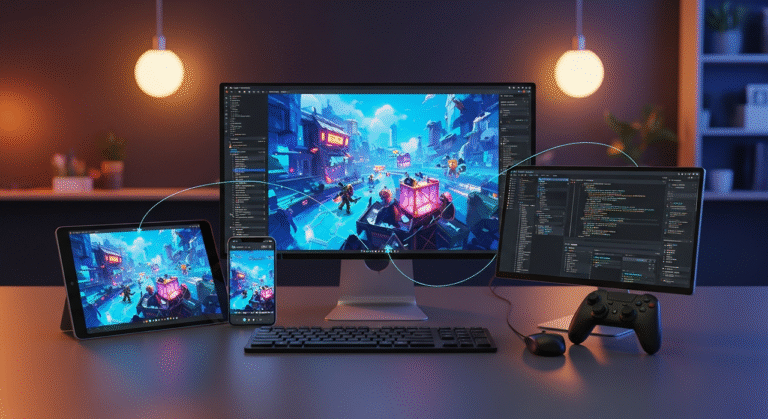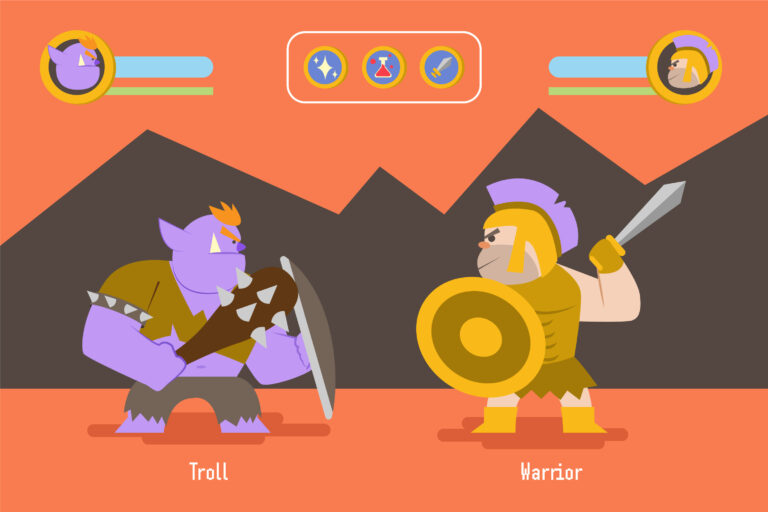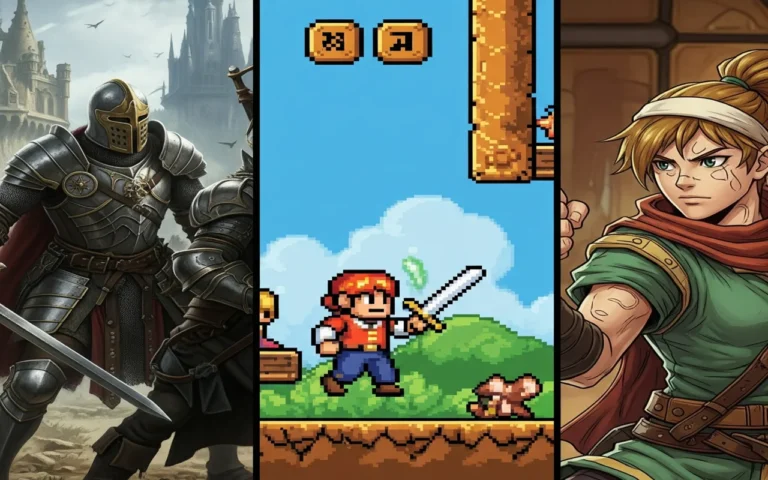Art direction shapes a game’s atmosphere and identity by guiding how players perceive and engage with the narrative and interface.
In game design, realistic and stylized art styles are two key approaches. Realistic visuals aim to closely replicate the real world with precision, while stylized art exaggerates or reimagines reality for a distinctive look.
Recognizing the strengths, limitations, and applications of each is essential for every developer, artist, and game art studio that seeks to create impactful experiences.
Let’s examine the differences between these approaches and their implications for players and creators.


Need Game Art Services?
Visit our Game Art Service page to see how we can help bring your ideas to life!
What is Realistic Art Style?
A realistic art style aims to mirror the real world with precision, utilizing advanced techniques like photogrammetry and physically based rendering (PBR) to create accurate lighting, textures, and materials.
Games such as Red Dead Redemption 2 and The Last of Us Part II demonstrate how realism deepens immersion by placing players in convincing, lifelike settings.
This 3D art style is achieved through detailed 3D modeling, advanced lighting and shading techniques, high-resolution textures, and lifelike animations.
While this approach requires robust hardware and extensive development teams, it delivers strong emotional engagement and immersion.
Realistic visuals are ideal for narrative-focused, cinematic, or simulation-based games where authenticity is paramount.
What is Stylized Art Style?
Stylized art prioritizes creativity by exaggerating, simplifying, or abstracting reality, using distinctive shapes, proportions, textures, and colors to craft a unique visual identity.
Games like Fortnite, Cuphead, and The Legend of Zelda: Breath of the Wild exemplify this approach.
Unlike photorealism, stylized visuals age well, relying on artistic vision rather than advanced technology. This style enables smaller studios to create striking, memorable aesthetics while keeping production costs lower and more manageable.
How Do Realistic and Stylized Art Styles Differ?
Realistic and stylized exist on a spectrum of game art styles, not as opposites! Many games blend elements of both, such as stylized characters in realistic settings or vice versa.
The choice between them depends on narrative objectives, technical capabilities, and audience preferences.
Realism shines in delivering immersive, emotionally resonant experiences, while stylization offers creative flexibility and enduring visual appeal.
Examining factors like lighting, textures, materials, proportions, animations, and camera effects reveals how each style influences the player’s experience.
Lighting
In realistic art, lighting replicates natural physics through techniques like ray tracing, global illumination, and dynamic shadows, creating authentic, cinematic environments.
In contrast, stylized art employs lighting creatively through using bold color gradients, flat shading, or striking contrasts to enhance mood and tone.
For example, Overwatch leverages exaggerated highlights and simplified shadows for clear, vibrant gameplay, while realistic games like Cyberpunk 2077 use intricate neon lighting to deepen immersion.
Textures
Realistic textures focus on precision, using high-resolution maps derived from scanned surfaces like stone, wood, or skin to capture wear, dirt, and fine details.
On the other hand, stylized texturing often features hand-painted designs, bold outlines, or simplified shading for a unified aesthetic.
For instance, Sea of Thieves employs smooth, cartoonish textures to maintain a playful pirate vibe, while Call of Duty: Modern Warfare II uses detailed material surfaces for gritty realism.
Materials
In realistic games, material rendering relies on physically based rendering (PBR) to ensure accurate light reflection on metals, refraction in glass, and the natural behavior of cloth.
Stylized art takes a more creative approach, using exaggerated highlights or flat tones on materials to align with the game’s aesthetic.
In other words, realism prioritizes physical accuracy, while stylization emphasizes visual consistency. Material choices significantly influence believability, performance, and the overall cohesion of the visual style.
Proportions
Realistic art adheres to natural proportions, with characters, objects, and environments modeled to reflect accurate human anatomy and scale for believability.
Stylized art manipulates proportions, such as featuring oversized heads, exaggerated limbs, or simplified shapes, to convey personality and emotion.
For example, World of Warcraft uses enlarged weapons and body shapes for dramatic flair, while Assassin’s Creed Valhalla maintains realistic proportions.
Animations
Realistic animations focus on lifelike precision, using motion capture and physics-driven movements to detail everything from footsteps to facial expressions.
Stylized animations prioritize expressiveness, often using exaggeration for clarity or charm, as seen in Cuphead’s “rubber hose” style inspired by 1930s cartoons.
Realistic games like Death Stranding use subtle, motion-captured animations to enhance immersion.
Camera Effects
Realistic art styles employ cinematic camera effects like lens flares, depth of field, chromatic aberration, and motion blur to emulate film and enhance immersion.
Stylized games often use minimal or playful camera effects to maintain visual clarity and readability.
For instance, Borderlands pairs cel-shaded visuals with a restrained camera setup to prioritize clarity.
Player Perspectives
Realism affects players’ behavior in the game with deep immersion and emotional resonance by mimicking real-world logic, pulling them into believable settings.
Stylized art, by contrast, feels more accessible, whimsical, or imaginative, making it easier for players to suspend disbelief.
While realistic visuals can stun, they might feel odd if not executed correctly. Stylized art maintains consistency even with limited resources, creating cohesive worlds.
What Are the Pros and Cons of Realistic vs. Stylized Art Styles?
Realistic art excels in delivering immersive, cinematic experiences with strong emotional impact but demands significant budgets, large teams, and cutting-edge hardware. It also risks becoming dated as technology evolves.
Stylized art is budget-friendly, distinctive, and timeless, adapting well across platforms. However, it may lack the immediate visual impact of realism and could turn off players craving authenticity.
Technical artists must balance artistic goals, hardware considerations, and audience preferences when choosing a style.
Which Art Style Is More Popular or Impactful?
Art style popularity ties to cultural shifts, technological advancements, and player demographics.
Realism prevails in AAA games due to their cinematic allure and marketing strength, appealing to audiences seeking spectacle.
Stylized art flourishes in indie and cross-platform games, offering versatility and bold brand identity. Titles like Minecraft and Fortnite prove stylized visuals can achieve widespread success, while AAA franchises push realism’s boundaries.
Both indie and AAA styles shape how games are perceived, marketed, and remembered in gaming culture.
What Are Some Examples of Stylized and Realistic Art Styles in Games?
Specific game examples illustrate how art styles shape player experiences, highlighting distinct design priorities.
Realistic art emphasizes immersion through lifelike visuals, while stylized art prioritizes creative expression. Hybrid approaches combine elements of both to a unique effect.
Let’s review some of the most renowned titles in the industry and their arty style:
The Last of Us Part II
The Last of Us Part II employs hyper-realistic visuals to create an emotionally gripping and immersive experience.
Its detailed character models, lifelike animations, and meticulously crafted environments, like overgrown urban ruins, draw players into a post-apocalyptic world.
The realistic art style enhances the game’s narrative-driven focus, making every scene feel visceral and emotionally resonant, reinforcing its cinematic storytelling.
Red Dead Redemption 2
Red Dead Redemption 2 showcases realism through sprawling, authentic landscapes and intricate details, from dynamic weather to lifelike NPC behaviors.
Its use of physically based rendering (PBR) and advanced lighting techniques creates a believable Wild West setting.
This immersive art direction deepens background design and players’ connection to the story and world, making exploration and interactions feel grounded and impactful.
Cuphead
Cuphead’s art style, inspired by 1930s cartoons, features hand-drawn “rubber hose” animations and a retro aesthetic.
Its exaggerated proportions and vibrant palette create a unique, nostalgic charm that sets it apart. This stylized direction not only defines the game’s identity but also supports its challenging gameplay by ensuring visual clarity and expressiveness.
Fortnite
Fortnite employs a colorful, cartoonish, stylized art style with simplified textures and exaggerated character designs.
This approachable aesthetic broadens its appeal across diverse audiences and supports its fast-paced, competitive gameplay. The stylized visuals remain consistent across platforms, contributing to its widespread popularity and enduring cultural impact.
The Legend of Zelda: Breath of the Wild
The Legend of Zelda: Breath of the Wild uses a cel-shaded, stylized art style with soft colors and painterly textures to create a vast, inviting open world.
Its minimalist yet expressive design emphasizes exploration and creativity, aging gracefully compared to realistic visuals. This approach enhances the game’s timeless appeal and emotional connection with players.
How Can You Choose the Best Art Style for Your Game?
Choosing an art style for games involves weighing budget, team skills, and long-term objectives.
Developers must evaluate factors such as the target audience, platform constraints, game genres expectations, and marketing strategies.
For example, a survival horror game may benefit from realism to heighten tension, while a playful platformer might thrive with a stylized approach.
Here’s a brief breakdown:
- Budget: Realistic art requires far greater financial resources compared to stylized titles. Indies lean towards stylization.
- Target Platform: Photorealism demands powerful modern consoles and gaming PCs. Stylized games can support more platforms. It could be a great mobile game art style.
- Target Audience: Younger players often prefer stylized looks, while older gamers value realism more. Genres like shooters suit realism better.
- Artistic Intent: Studios with a strong, unified vision can leverage stylization effectively. Realism excels at authenticity.
- Immersion Goals: Realism boosts immersion in lifelike worlds, but stylization also immerses players with cohesion.
Stylized art can foster strong brand identity, whereas realism appeals to players seeking high-fidelity visuals.
The ideal choice depends on how well the art style enhances gameplay mechanics and supports the narrative vision, rather than simply following current trends.
Final Words
The discussion of realistic versus stylized art styles centers on appropriateness, not superiority!
Each approach offers distinct advantages that influence player immersion, creative expression, and lasting impact.
Developers face the task of aligning their art direction with both creative aspirations and practical limitations.
Whether through the immersive detail of realism or the vibrant creativity of stylization, the selected art style becomes a game’s defining visual identity, shaping how it resonates with players and leaves its mark on the industry.
FAQs
What defines realistic vs. stylized game art?
Realistic aims for believability and detail; stylized emphasizes mood, exaggeration, and creative expression.
What are the key visual differences?
Realism uses detailed textures, accurate lighting; stylized relies on flat colors, hand‑painted textures, or artistic abstraction.
Why choose stylized art?
Stylized art offers creative freedom, faster production, and timeless visuals that perform well across platforms.
When is realism preferred in games?
Realism is chosen for high-budget, immersive projects where lifelike visuals enhance storytelling and player immersion.
Can both styles be used together?
Yes. Many games use a hybrid “stylized realism” approach. Realistic lighting with stylized characters for unique aesthetics.
Which style is better for mobile games?
Stylized art often works better for mobile, as it’s easier to render, stands out visually, and handles performance better.
Does style affect development time?
Yes. Stylized art typically speeds up development; realism requires more effort for detailed assets and lifelike rendering.
Why do stylized games age better?
Stylized games can stay visually fresh longer as their style doesn’t chase ever‑advancing realism standards.









